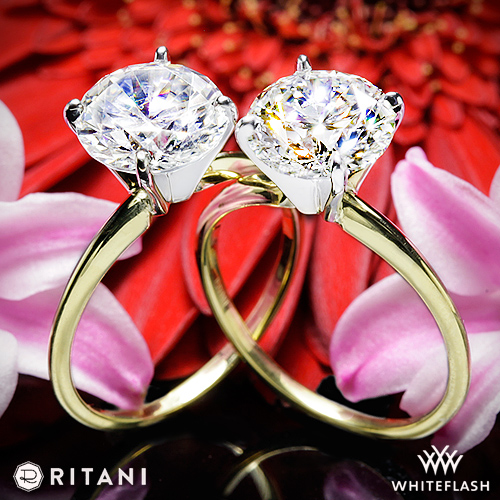This page contains references to diamonds or engagement rings from different companies. Sometimes I do receive a commission when you click on links and buy the products.
At a first glance, with one eye closed, from a distance…you could perhaps confuse cubic zirconia for a diamond. White, or colorless diamonds continue to be the most popular choice for engagement rings and fine jewelry, so most of the cubic zirconia produced are clear in a bid to match the appearance of a diamond.
Cubic zirconia has its place; this guide will be taking a look at whether that place is in fine jewelry. Making a direct comparison between cubic zirconia and diamonds will unveil everything you need to know on matters of durability, cost, scarcity and beauty.
What is a Cubic Zirconia?
Cubic zirconia is a synthetic gemstone. Usually it is colorless to meet market demands, although it can be produced in a variety of colors. They can appear naturally within baddeleyite (a mineral), although it is extremely rare. All of the cubic zirconia used in jewelry is lab created.
The process of creating cubic zirconia changes from lab to lab, but the basic principles involve a mixture of zirconium oxide powders which are stabilized with calcium and magnesium – labs will sometime add other materials to better resemble the appearance of a diamond. The entire process of a diamond forming naturally in the earth takes between 1 billion and 3.3 billion years. Cubic zirconia can be made at lightning speed by following the lab processes. The producers of cubic zirconia can alter the color and create synthetic gemstones that mimic a variety of diamond shapes.
Why is Cubic Zirconia Cheaper than Diamonds?
Anyone wanting to make the most from their engagement ring/jewelry budget is likely to be curious about the big difference in price between cubic zirconia and diamonds. The answer to this question rests in the formation, beauty and scarcity of diamonds which we will be looking at closely in a moment.
If we use this 2.00ct cubic zirconia engagement ring as an example, it costs less than $20.00. This 2.18 carat h-vs2 excellent cut round diamond from James Allen is over $16,000. But this difference in price is a direct reflection of the complete difference in appearance, formation and durability. It is like comparing apples to oranges.
You will notice that a large majority of cubic zirconia is set in silver or another semi-precious metal. Again, this is a reflection on the value of the synthetic gemstone – a gold or platinum setting would cost more than the stone itself so most retailers decide it’s not worth it. It is possible to get CZ’s set in precious metals; when cubic zirconia first came onto the market, some companies believed it would be a true rival for diamonds. Despite this proving incorrect, you will still find retailers who boast higher quality cubic zirconia and set them in precious metals. They put their prices higher, but as cubic zirconia is lab created, there is negligible difference in quality.
This 1.00ct round cut cubic zirconia ring is over $800 when set in 18k gold. This is an example of a hugely inflated price for a synthetic ring. The website adds $200 for an 18k setting, so you are paying around $600 for a cubic zirconia with absolutely zero discernible differences from the $20 ring. Even with lower prices, you can still get ripped off buying a synthetic gemstone.
A cubic zirconia has very little value, so it is unlikely you will ever sell your ring on (if you do, it will be for pennies).
To really understand the price differences, we need to look at the other striking differences between the two gemstones.
Beauty
If you have read any diamond guides, you will know that the most important of the four c’s is the cut. The cut of a diamond will dictate how well the diamond handles light, and it is this light performance which creates the distinct optical properties that we see in a diamond.

CZ vs 2.524ct J VS2 ACA from Whiteflash
Fire: The term fire refers to dispersed light which creates the rainbow flashes of colored light in a diamond. Fire is best seen in low light, particularly candle light. If you’ve ever caught a flash of a diamond in a candlelit restaurant you will know the striking and distinctive appearance that this optical effect has. Cubic zirconia has a higher dispersion rate than a diamond (around 0.066 VS 0.044); this causes rainbow light be the main visual property and can create an overly colourful ‘disco ball’ appearance. It is one of the easiest ways to spot a synthetic gemstone.
Brilliance: This is the white light that reflects and refracts from a well-cut diamond. It is the foundation of brightness and sparkle. As a diamond is so hard, it is finished with an extremely high polish which allows it to reflect and refract light. A cubic zirconia is not as hard as a diamond, so it cannot be cut and polished to the same level and it has a much lower refractive index (2.15 VS 2.42).
Scintillation: This refers to the blinking effect that creates the distinct sparkle in a diamond. It is a balance of black and white areas that cause pleasing flashes across the diamond as it moves. As a cubic zirconia handles light so differently, scintillation is difficult to see as it is overpowered by the excess of rainbow light. As a result, a CZ will not sparkle the same way as a diamond and will appear flat and dull in artificial light.
These are some of the key optical properties that give diamonds their coveted sparkle and brightness. The absence of these in a CZ means they perform completely differently and lack power and presence of a diamond.
Durability
A diamond is the hardest, naturally occurring mineral in the world. The Mohs scale (0-10) is used to measure the hardness of materials and diamonds receive a perfect 10. This is one of the reasons they are perfect for engagement rings and every day jewelry. They require minimal maintenance and will retain their sparkle for years to come.
Cubic zirconia scores an 8.5 on the Mohs scale; with this ranking, it is a durable material but can still be scratched by other substances. Over the years, a CZ will become cloudy and lose all sparkle. These changes can take time, but in many cases, you will notice damage and a change in appearance after the first two years of wearing a CZ every day.
If you bought the $800 CZ ring and replaced it every two years, after ten years of blissful romance you would have spent $4,000! This stunning 0.70ct I-VS2 round brilliant from Whiteflash is $2,466 – pair with one of their designer settings like this Ritani solitaire and you’re still under the $4,000 mark.
An engagement ring is an investment and you want to know it’s going to last.
Color and Clarity
As CZ’s are lab created, they are made to be ‘perfect’. This means there is no color or inclusions. Although this can seem like a positive, as they lack the other properties (brilliance, scintillation etc) the result is a glassy, flat appearance that makes them instantly recognisable as fake.
Inclusions are like birthmarks; they make your diamond entirely unique and one of a kind. Inclusions can affect the sparkle of a diamond if there are a lot of them or if their position is particularly obvious. However, this is easily avoided by selecting a good clarity grade (SI1 and above) and by taking advantage of the high-res imaging offered by reputable vendors such as Whiteflash and James Allen.
The Final Word and Where to Buy Diamonds
Cubic zirconia should not be considered a substitute for a diamond. It is an excellent choice for costume jewelry due to its low cost and attractive appearance, however if you are looking for a sparkle that will last a lifetime and jewelry that can be worn every day, a diamond is always the best choice.
If you have the opportunity to view a diamond and a CZ side by side, the differences will become apparent. Intensity, unrivalled sparkle and an entirely unique appearance will set a diamond apart every time.
Where to buy: I highly recommend Whiteflash for their exceptionally high-quality diamonds and their commitment to a proper diamond education with light performance imaging and HD Video on all diamonds. They also hold an impressive portfolio of designer settings.
James Allen carry a large portfolio of diamonds. Their vast selection make them a great place to start getting to grips with viewing and analyzing diamonds and a third option would also be Blue Nile.

Richard Jenkins, The Diamond Guru
Get free assistance from the Diamond Guru today. You’ll be glad you did!
- Secure the best quality diamond for your budget.
- Don’t pay over the odds for your diamond ring.
- Have peace of mind that you didn’t get ripped off.
Have a Question? Contact us now…

